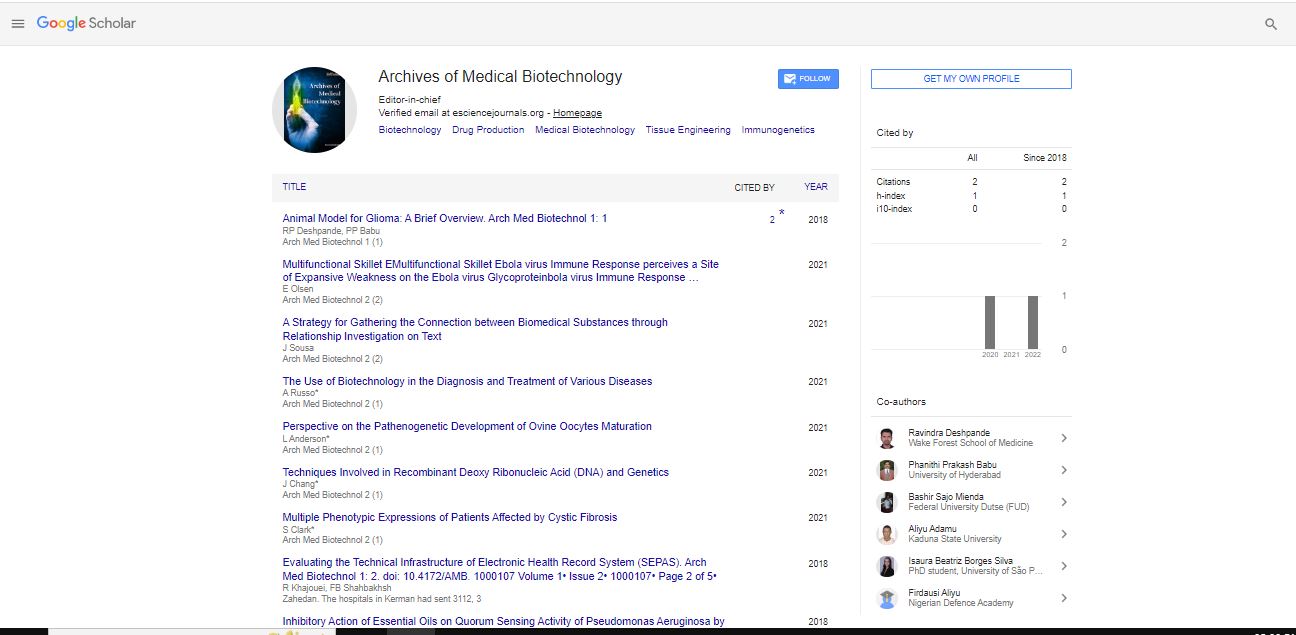Opinion Article, Arch Med Biotechnol Vol: 4 Issue: 2
Optimizing Drug Delivery by Deploying Nanomaterials
Josaph Crotel*
Department of Biology, Nebraska Wesleyan University, 5000 Saint Paul Avenue, Lincoln, NE 68504, USA
*Corresponding Author: Josaph Crotel,
Department of Biology, Nebraska
Wesleyan University, 5000 Saint Paul Avenue, Lincoln, NE 68504, USA;
E-mail: Josaphc@aberdeen.ac.edu
Received date: 22 May, 2023, Manuscript No. AMB-23-106366;
Editor assigned date: 24 May, 2023, PreQC No. AMB-23-106366 (PQ);
Reviewed date: 16 June, 2023, QC No. AMB-23-106366;
Revised date: 26 June, 2023, Manuscript No. AMB-23-106366 (R);
Published date: 03 July, 2023 DOI: 10.4172/amb.1000047.
Citation: Crotel J (2023) Optimizing Drug Delivery by Deploying Nanomaterials. Arch Med Biotechnol 4:2.
Abstract
Nanotechnology has revolutionized the field of drug delivery by enabling the design and development of targeted and controlled release systems. Providing an overview of the role of nanotechnology in drug delivery systems, by discussing the unique properties of nanomaterials that make them ideal for drug delivery, including their high surface area, tunable size, and ability to encapsulate and protect drugs. The manuscript also explores various nanocarrier systems, such as liposomes, nanoparticles, and dendrimers, and their applications in delivering a wide range of therapeutic agents. Nanotechnologybased drug delivery systems have the potential to enhance drug efficacy, reduce side effects, and improve patient outcomes.
Keywords: Nanotechnology; Drug delivery systems; Liposomes
Description
The effective delivery of therapeutic agents to their intended targets is a critical factor in the success of drug therapies. Nanotechnology offers innovative solutions by utilizing nanoscale materials as carriers for drugs. Nanoscale drug delivery systems can improve drug efficacy, provide controlled release, and enhance targeted delivery to specific tissues or cells.
Properties of nanomaterials
Nanomaterials possess unique properties that make them suitable for drug delivery applications. Their high surface area-to-volume ratio allows for efficient drug loading, and their tunable size enables precise control over drug release kinetics. Additionally, nanomaterials can protect drugs from degradation and enhance their solubility, stability, and bioavailability.
Nanocarrier systems
Various nanocarrier systems have been developed for drug delivery, each offering distinct advantages and applications. Liposomes are lipid-based vesicles that can encapsulate both hydrophilic and hydrophobic drugs, enabling their efficient delivery to target sites. Nanoparticles, such as polymer nanoparticles and metallic nanoparticles, offer flexibility in drug loading and can be functionalized to achieve active targeting. Dendrimers, highly branched polymer structures, can encapsulate drugs within their interior or conjugate them on their surface, facilitating controlled release and targeted delivery.
Applications in drug delivery
Nanotechnology-based drug delivery systems have found applications in delivering a wide range of therapeutic agents, including small molecules, proteins, peptides, nucleic acids, and even gene editing tools like CRISPR-Cas9. These systems have been employed in the treatment of various diseases, including cancer, infectious diseases, and neurological disorders. Nanoparticles can selectively accumulate in tumor tissues through the enhanced permeability and retention effect, enabling targeted drug delivery and minimizing systemic toxicity.
Advantages and challenges
Nanotechnology-based drug delivery systems offer several advantages over traditional drug formulations. They can enhance drug stability, improve pharmacokinetics, and reduce the frequency of administration. Targeted delivery can increase drug concentrations at disease sites while minimizing exposure to healthy tissues, reducing side effects. However, challenges such as scale-up production, regulatory considerations, and potential long-term toxicity of nanomaterials require careful evaluation and further research.
Conclusion
Nanotechnology has revolutionized drug delivery systems by enabling targeted and controlled release of therapeutic agents. The unique properties of nanomaterials and the development of various nanocarrier systems have paved the way for more effective and personalized drug therapies. With continued research and advancements in nanotechnology, drug delivery systems have the potential to significantly improve drug efficacy, reduce side effects, and enhance patient outcomes.
 Spanish
Spanish  Chinese
Chinese  Russian
Russian  German
German  French
French  Japanese
Japanese  Portuguese
Portuguese  Hindi
Hindi 